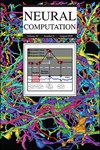Cooperativity, Information Gain, and Energy Cost During Early LTP in Dendritic Spines
IF 2.7
4区 计算机科学
Q3 COMPUTER SCIENCE, ARTIFICIAL INTELLIGENCE
引用次数: 0
Abstract
We investigate a mutual relationship between information and energy during the early phase of LTP induction and maintenance in a large-scale system of mutually coupled dendritic spines, with discrete internal states and probabilistic dynamics, within the framework of nonequilibrium stochastic thermodynamics. In order to analyze this computationally intractable stochastic multidimensional system, we introduce a pair approximation, which allows us to reduce the spine dynamics into a lower-dimensional manageable system of closed equations. We found that the rates of information gain and energy attain their maximal values during an initial period of LTP (i.e., during stimulation), and after that, they recover to their baseline low values, as opposed to a memory trace that lasts much longer. This suggests that the learning phase is much more energy demanding than the memory phase. We show that positive correlations between neighboring spines increase both a duration of memory trace and energy cost during LTP, but the memory time per invested energy increases dramatically for very strong, positive synaptic cooperativity, suggesting a beneficial role of synaptic clustering on memory duration. In contrast, information gain after LTP is the largest for negative correlations, and energy efficiency of that information generally declines with increasing synaptic cooperativity. We also find that dendritic spines can use sparse representations for encoding long-term information, as both energetic and structural efficiencies of retained information and its lifetime exhibit maxima for low fractions of stimulated synapses during LTP. Moreover, we find that such efficiencies drop significantly with increasing the number of spines. In general, our stochastic thermodynamics approach provides a unifying framework for studying, from first principles, information encoding, and its energy cost during learning and memory in stochastic systems of interacting synapses.树突棘早期 LTP 期间的合作性、信息增益和能量成本
我们在非平衡随机热力学的框架内,研究了由相互耦合的树突棘组成的大规模系统在 LTP 诱导和维持的早期阶段中信息与能量之间的相互关系,该系统具有离散的内部状态和概率动态。为了分析这种难以计算的随机多维系统,我们引入了一种成对近似方法,它使我们能够将脊柱动力学还原为一个可管理的低维封闭方程系统。我们发现,在 LTP 的初始阶段(即刺激期间),信息增益率和能量达到最大值,之后它们会恢复到基线低值,这与持续时间更长的记忆痕迹不同。这表明学习阶段比记忆阶段需要更多的能量。我们的研究表明,在 LTP 期间,相邻棘突之间的正相关性会增加记忆痕迹的持续时间和能量成本,但当突触合作性非常强、呈正相关性时,每投入能量的记忆时间会急剧增加,这表明突触集群对记忆持续时间起着有益的作用。与此相反,负相关的 LTP 后信息增益最大,而该信息的能效通常会随着突触合作性的增加而降低。我们还发现,树突棘可以使用稀疏表征来编码长期信息,因为在 LTP 期间,当刺激突触的比例较低时,保留信息的能量效率和结构效率及其寿命都会达到最大值。此外,我们还发现,随着棘突数量的增加,这种效率会显著下降。总之,我们的随机热力学方法提供了一个统一的框架,可以从第一性原理出发,研究信息编码及其在相互作用突触的随机系统中学习和记忆过程中的能量成本。
本文章由计算机程序翻译,如有差异,请以英文原文为准。
求助全文
约1分钟内获得全文
求助全文
来源期刊

Neural Computation
工程技术-计算机:人工智能
CiteScore
6.30
自引率
3.40%
发文量
83
审稿时长
3.0 months
期刊介绍:
Neural Computation is uniquely positioned at the crossroads between neuroscience and TMCS and welcomes the submission of original papers from all areas of TMCS, including: Advanced experimental design; Analysis of chemical sensor data; Connectomic reconstructions; Analysis of multielectrode and optical recordings; Genetic data for cell identity; Analysis of behavioral data; Multiscale models; Analysis of molecular mechanisms; Neuroinformatics; Analysis of brain imaging data; Neuromorphic engineering; Principles of neural coding, computation, circuit dynamics, and plasticity; Theories of brain function.
 求助内容:
求助内容: 应助结果提醒方式:
应助结果提醒方式:


